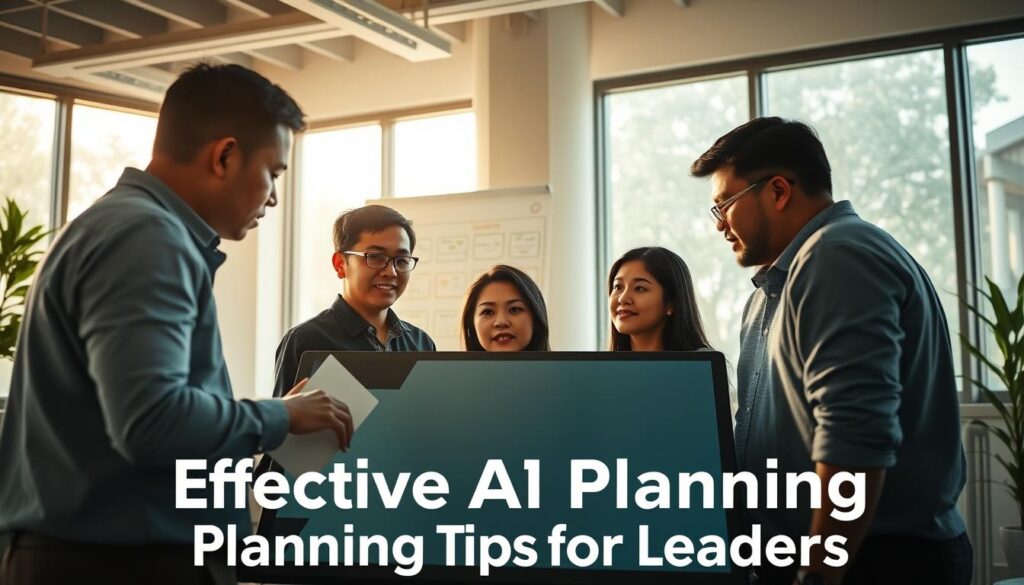In Southeast Asia, businesses are quickly adopting artificial intelligence. Yet, a shocking truth is that over 80% of AI and machine learning projects stall at the proof-of-concept stage. What’s stopping these projects from succeeding? Ignoring the importance of effective AI change management is a major mistake. This article will explore common pitfalls and offer solutions to ensure success.
By following the best practices for AI integration, companies can greatly improve their chances of successful AI transformation. This is crucial for achieving the full benefits of AI.
Many companies are ready to give up on one-third of their generative AI projects after the pilot phase. It’s clear that understanding these pitfalls is key. Effective change management can cut project failure rates by up to 70% by tackling challenges early on.
In the next sections, we’ll look at the main barriers to successful AI implementations. We’ll also share tips on how to overcome these obstacles. This way, your organization can fully benefit from AI capabilities.
Key Takeaways
- More than 80% of AI projects stagnate in the proof-of-concept stage.
- Effective AI change management can significantly mitigate failure rates.
- Many organizations lack clear business objectives for their AI initiatives.
- Involving employees in decision-making boosts adoption rates by 30%.
- Structured change management practices can accelerate implementation by 50%.
- Engaging stakeholders early can help avoid pitfalls later in the project.
- Regular feedback sessions enhance employee satisfaction and commitment.
Understanding AI Change Management
AI change management is about smoothly adding artificial intelligence to companies. It means making sure AI fits well with how a business already works. This helps everyone get used to new tech easily.
In Southeast Asia, companies face special AI project management challenges. They have to deal with limited resources and not always good data. Knowing these issues is key before starting any AI project.
To manage AI projects well, you need to spot risks early and plan how to fix them. Most AI problems come from mistakes, not bad intentions. With 92 different AI failure cases, it’s crucial to fix AI system weaknesses before they cause trouble.
AI systems are complex, which can lead to surprises. The normal accident theory shows that big, complicated systems often make mistakes. So, it’s vital to focus on clear, easy-to-understand AI change management. Good training helps teams deal with tricky AI examples and understand what AI does.
Common AI Change Management Pitfalls
Introducing Artificial Intelligence in companies often hits roadblocks. Knowing these hurdles helps businesses make better AI plans. Mistakes in AI use can waste resources and lead to project failures. By matching AI plans with business goals and keeping strategies simple, companies can better integrate AI.
Failure to Align AI with Business Goals
Many companies start AI without clear goals. This can lead to wasted effort and resources. Employees may also resist AI changes if they’re not sure what’s expected. Setting clear goals helps guide AI use and ensures it helps the company succeed.
Using smart AI deployment tips helps set focused goals that match the company’s vision.
Overcomplicated AI Strategies
Some companies create too complex AI plans. This can confuse teams, slow down projects, and increase costs. Keeping things simple and clear is key to avoiding AI mistakes.
Designing AI for ease of use and straightforward methods helps teams work better. It creates a space for trying new things and learning.

Key AI Mistakes to Avoid
Using AI technologies can be tricky for companies. It’s important to know and fix common mistakes to get the most out of AI. Understanding these errors helps avoid risks and ensures AI works well.
Neglecting Data Quality and Integrity
One big mistake is ignoring data quality. Bad data can make AI predictions wrong up to 90% of the time. Making sure data is good is key to getting accurate insights.
Companies that don’t focus on data quality often face big problems. They might see their projects fail more often. Not having a strong AI system can make things worse.
Ignoring Change Management Practices
Another mistake is not planning for changes when using AI. Good AI use needs practices that help employees learn and adapt. If companies ignore these changes, productivity can drop by 30%.
Getting people involved early can make AI projects up to 40% more likely to succeed. Companies that don’t plan for these changes might waste a lot of resources. It’s important to have clear ways to communicate and support during these changes.

| Mistake | Consequences | Best Practices |
|---|---|---|
| Neglecting Data Quality | 90% inaccurate predictions | Implement rigorous data integrity protocols |
| Ignoring Change Management | 30% decrease in productivity | Engage stakeholders; ensure transparent communication |
| Poor Planning | 70% resource waste | Establish clear goals; involve multiple departments |
| Over-Reliance on Black Box Models | Increased accountability issues | Ensure transparency in AI decision-making |
Importance of Clear, Measurable Goals in AI Projects
Setting clear, measurable goals is key to successful AI adoption. Teams use SMART goals to stay focused and make progress. These goals help align AI projects with business goals, ensuring projects are effective and resources are used wisely.
Teams with clear AI goals are 2.5 times more likely to succeed. Studies show a 70% jump in success rates with measurable goals. This approach helps navigate AI’s complexities and reduces risks from unclear targets.

Quality data is crucial for AI project success. AI projects with good data see a 30% drop in errors. Investing in AI training boosts team performance and engagement, leading to better AI execution.
Setting KPIs for AI projects helps evaluate success and make adjustments. This ongoing monitoring improves AI accuracy, driving real results for the organization.
Effective AI Planning Tips for Leaders
Leaders who want to use AI well need good planning tips. A detailed plan helps make big changes in companies. Starting with a data audit is key.
Conducting a Comprehensive Data Audit
A data audit is crucial for AI success. Companies must check their data, finding what works and what doesn’t. Making sure all data systems work together helps AI projects run smoothly.
Regular checks on data quality keep it reliable and trustworthy.
Establishing Support at the Executive Level
Getting top leaders on board with AI is important. It helps get the resources needed and boosts team spirit. Talking clearly about AI’s benefits helps everyone see its value.
This support is the base for AI success, making sure it fits with the company’s goals.

Encouraging Team Experimentation with AI
Creating an innovative environment is key for team collaboration in AI. By letting teams try out AI, companies help employees find new ways to work better. This approach makes everyone feel part of the team and connected.
Fostering a Culture of AI Exploration
Leaders must make the workplace welcoming for AI projects. They should listen to everyone, welcome ideas, and ask for feedback often. A strong AI culture helps companies get the most out of their investments, making things run smoother.
Teams that get hands-on with AI can keep improving their methods. This leads to better results and more success in AI projects.
Studies show that companies with a good AI culture do much better. They see a 30% jump in AI success. Also, diverse teams come up with 20% more creative solutions. These practices boost creativity and make employees more committed to AI.
Offering chances to learn helps teams adjust to new AI insights. As companies try out different AI tools, they can see what works best. This approach leads to lasting success and better processes.
Here are some key things to help foster a culture of AI experimentation:
| Key Elements | Impact |
|---|---|
| Encouraging Suggestions | Enhances innovation and team involvement |
| Regular Feedback | Improves AI application effectiveness |
| Hands-On Experience | Develops practical skills and confidence |
| Diverse Teams | Increases creativity and problem-solving |
| Continuous Learning | Facilitates adaptation to new technologies |
Training and Development for AI Adoption
For AI adoption to succeed, training and development are key. Companies need to prepare their teams with the right skills. They also must create an environment where AI can thrive. It’s important to address fears about job loss to keep employees on board.
Investing in employee training is crucial. It helps organizations overcome initial hurdles. It also prepares the workforce for the future.
Balancing Skill Training and Adoption Encouragement
Training for AI should focus on both skills and technology adoption. Continuous learning is vital. It helps employees grow their AI skills and perform better.
Companies that offer mentoring, online courses, and workshops see big improvements. Employees become more confident and productive with AI.
Here are some key statistics that show why training is essential:
| Key Statistics | Implication |
|---|---|
| 94% of business leaders believe AI is critical to success in the next five years | Training programs must align with strategic organizational goals. |
| 87% of AI projects never go into production | A skilled workforce is paramount for turning concepts into successful implementations. |
| 70% of executives report their organizations lack a clear understanding of AI technologies | Educational initiatives can bridge knowledge gaps and optimize project execution. |
| 80% of AI projects are stalled due to a lack of stakeholder involvement | Involve decision-makers early to ensure alignment and resource allocation. |
Companies that focus on AI skills in their workforce do well. They avoid AI project risks and encourage innovation. Training should meet specific needs and promote AI’s benefits.
This approach boosts technical skills and confidence. It helps employees navigate the changing tech world.
Scalability in AI Deployment
Scalability is key for AI systems to work well. Without planning for scalable AI, many companies face big problems. These issues can make things less efficient and miss out on growth chances.
But, companies that plan well for AI scalability see big wins. For example, they can make 10% more money and cut costs by 20%.
Ignoring scalability can lead to big losses. A robot in Hong Kong lost $20 million a day because it wasn’t scaled right. This shows how important it is to tackle AI scaling challenges.
Working together in a company is vital for AI success. Silos in decision-making can cause problems. Doing a deep check of data and systems helps find where to start strong.
Jumping into AI without a plan can lose trust and cause problems. Knowing both short-term and long-term costs is key. Not seeing the big picture can lead to mistakes.
In short, to deploy AI well, you need good planning and focus on scalability. Companies should work on solving AI scaling issues to make sure systems work well and add value.
Conclusion
The path to successful AI change management is complex and requires careful planning. It’s becoming key in sectors like insurance and employee benefits. To make the most of AI, companies must focus on AI change management best practices. This includes aligning AI with business goals and setting clear, measurable targets.
Ignoring these steps can lead to big problems. Many companies have faced issues. But, by using strategies for overcoming AI challenges, like doing thorough data checks and budgeting well, risks can be lowered. It’s also important to be able to grow and change AI solutions as technology advances.
As the world changes, companies in Southeast Asia should get expert help. This ensures their AI projects stay relevant now and in the future. The summary of AI implementation insights shows the need for clear plans, skilled people, and ongoing support. Use these tips to move forward with AI and achieve success.

